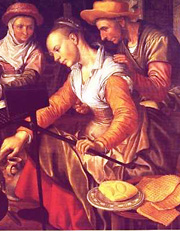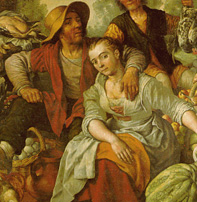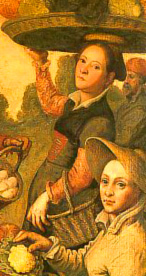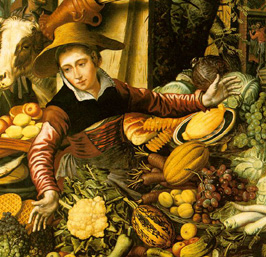 Fabric dyed woad blue could be overdyed by a madder solution to produce
plummy reds, dark purple-blues, and everything inbetween; it could also be
re-dyed in a pot of weld dye to create any number of greens, the most
famous being the "Lincoln Green" of Sherwood fame. Browns and Blacks
could be obtained using Black walnut, Oak galls, or iron oxide (rust)
alone or in combination with other dyes.
Fabric dyed woad blue could be overdyed by a madder solution to produce
plummy reds, dark purple-blues, and everything inbetween; it could also be
re-dyed in a pot of weld dye to create any number of greens, the most
famous being the "Lincoln Green" of Sherwood fame. Browns and Blacks
could be obtained using Black walnut, Oak galls, or iron oxide (rust)
alone or in combination with other dyes.
Add to this palette the newly imported dyes, such as indigo and cutch, that were becoming available to the lower classes, and you would see an impressive array of colors at any country fair. Reds, tans, dark greens, and all shades of brown tended to be popular among the Flemish lower classes, according to the paintings done by Aertsen, Beuckelaer and Brueghel in Flanders during the 1560s and 1570s. These artists also show black as a main color of lower class costume, usually as a partlet.
 When selecting the color for your peasant gown, gravitate towards "earthy"
or "natural" colors; avoid anything exceptionally bright, such as
the bright blue, red, yellow and purples of trigger fabric, for example.
Although peasants and lower class folk of Elizabethan times had access to
a number of colors, they were rarely as intense as their modern
counterparts; a woad "blue" would be duskier and slightly subdued, a
purple more blue-violet or plum-purple rather than "pure purple".
When selecting the color for your peasant gown, gravitate towards "earthy"
or "natural" colors; avoid anything exceptionally bright, such as
the bright blue, red, yellow and purples of trigger fabric, for example.
Although peasants and lower class folk of Elizabethan times had access to
a number of colors, they were rarely as intense as their modern
counterparts; a woad "blue" would be duskier and slightly subdued, a
purple more blue-violet or plum-purple rather than "pure purple".
Greys, buffs and olive-drab colors are always acceptable, even for the poorest beggars and wanderers. Such colours as "Rat" (grey), "puke" (khaki green) and "Goose-turd green" (self-explanatory) were worn by poor folk and the more unfortunate. Reds, from pinks through clear red to rust, plum, brick and burgundy colors are also good. Beware of stop-light screaming red, however; It was made using kermes or cochineal, an expensive dye available only to the wealthy. Grey-blue, light blue, dark blue, and medium blue are all acceptable, as are blue-greens and sea greens. Yellow-greens and dark hunter greens don't appear as often in peasant scenes, but were available. The bright greens we have nowadays were hard to obtain.
 Yellows show up often in peasant scenes, likely because there
are so many yellow dye-plants available. Any yellow you find in the
fabric store should do, if you avoid excessively neon yellows.
Browns are also a common color, and were found in every shade from russet
brown to chocolate brown to near black.
Yellows show up often in peasant scenes, likely because there
are so many yellow dye-plants available. Any yellow you find in the
fabric store should do, if you avoid excessively neon yellows.
Browns are also a common color, and were found in every shade from russet
brown to chocolate brown to near black.
During Elizabeth's reign, indigo as a dyestuff grew more and more popular. It was widely available and inexpensive, easy to transport in the form of dyecakes, and relatively permanent compared to many other dyestuffs of the time. As a result, it became a popular dye for the clothing of servants and others of a lower station. Soon, the color blue itself became associated with the state of servitude. As such, it is a good choice for someone wishing to dress as a maid, cook, or other type of servant.
 Despite regional myth, black was certainly available to the
majority
of the populace, not merely to the well-heeled. There are many methods of
making black dye which were open to the lower classes, and many scenes of
poorer folk wearing black. Of course, these blacks would bleach and fade
with use to a dark grey, brown or purple, depending on the dye used.
Keeping an item of clothing black was much
harder than dying it in the first place.
Despite regional myth, black was certainly available to the
majority
of the populace, not merely to the well-heeled. There are many methods of
making black dye which were open to the lower classes, and many scenes of
poorer folk wearing black. Of course, these blacks would bleach and fade
with use to a dark grey, brown or purple, depending on the dye used.
Keeping an item of clothing black was much
harder than dying it in the first place.
When buying white fabric, which was, for the lower classes, almost always used for undergarments, aprons or headwear, stay away from "optic white" or "pure white". There are many more shades of white than most people realize, until they're standing in front of twenty different whites at the fabric store. Choose a gentler white, or cream, for a peasant woman's shift, coif, partlet or apron. Not only is it more period, but it will blend better with other colors.
Needless to say, stay away from modern creations like fuchsia, aquamarine, all neons, and other obviously unnatural fabrics.
The Elizabethans had a number of names for various colors, names which differ somewhat from modern labels. What is "russet" now was "russet" then, but plum was called "murrey", and golden-brown fabric was "tawney". Pink was called "carnation", and a medium red was referred to as a "Bristol Red". "Watchet" was a popular color, a lighter blue/green. Fabric of a light yellow color was "Cane", "Primrose" or "Straw", depending on the shade, and there were a host of other names, including quite fanciful ones like "Dead Spaniard", "Ape's Laugh", "Mortal Sin", "Love Longing" and "Dawn".
Check out the Peasant Costume Gallery To view period portraits of servants, marketwomen, and other lower class women and men and get a first-hand look at the colors they wore. You can also look at Color in Elizabethan Dress has more detailed information about the color names of the time. If you're interested in trying your hand at period dying, this article on Period Dyes in the 16th century is a wonderful source of both historical dyeing info and instructions on using Elizabethan dyestuffs.
Home
 The clothing of Elizabethan peasants differed radically from that of
their betters, not only in content and fashion, but also in color. For
centuries preceding Elizabethan times, a
peasant woman would either dye her own wool using common dyes
readily available from garden and countryside, or would buy wool from a
nearby village weaver that had been dyed using the same colors and
dyestuffs. This practice held true for much of rural England's peasantry
during the 16th century. But don't imagine drab
greys, greens and ochres; even excluding the newly affordable
foreign
dyes, native plants and minerals provided a
rainbow of colors for even the poorest countrywoman's use. For servants,
laborers and other poor city-dwellers who didn't have the resources to dye
their own fabric, fabrics were obtained from local mercers or from their
own employers, and exhibited an even wider range of available color.
The clothing of Elizabethan peasants differed radically from that of
their betters, not only in content and fashion, but also in color. For
centuries preceding Elizabethan times, a
peasant woman would either dye her own wool using common dyes
readily available from garden and countryside, or would buy wool from a
nearby village weaver that had been dyed using the same colors and
dyestuffs. This practice held true for much of rural England's peasantry
during the 16th century. But don't imagine drab
greys, greens and ochres; even excluding the newly affordable
foreign
dyes, native plants and minerals provided a
rainbow of colors for even the poorest countrywoman's use. For servants,
laborers and other poor city-dwellers who didn't have the resources to dye
their own fabric, fabrics were obtained from local mercers or from their
own employers, and exhibited an even wider range of available color.